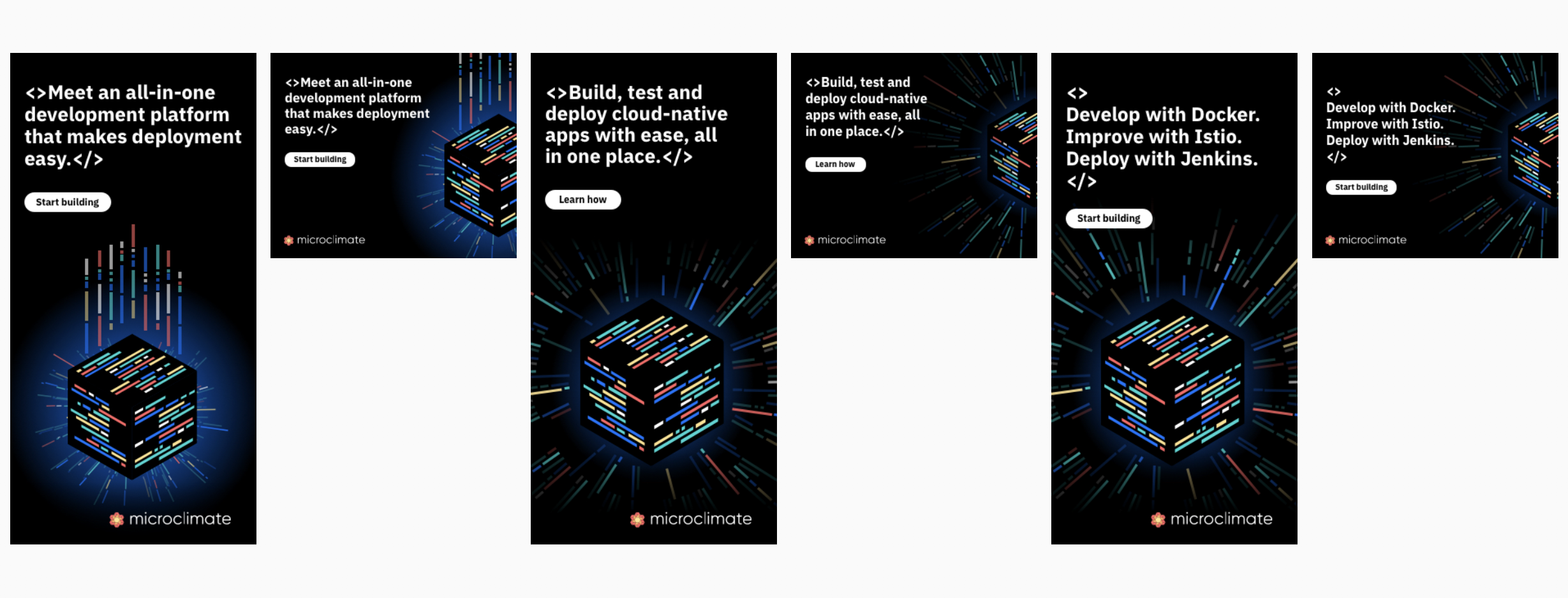From Monolith to Microservice
When you hear the words open-source, IBM may not be the first company name that comes to mind. This is true for most developers as we conducted 22 interviews that found the IBM was not on their radar and was perceived to be dated when it came to understanding this audience. With that in mind it was our job to change perception of IBM as a company, educate developers on their long history of open-source contributions and last, introduce a new product to market, Microclimate (an end-to-end containerized development platform for microservices).
So how do you market to an audience who doesn’t want to be marketed to?
CLIENT
IBM
OFFICE
Raleigh, NC
TYPE
Brand positions, concepting, activation and tactic planning, event strategy and design
ROLES
Creative Lead: Caroline Schaffer
Concept Team: Caroline Schaffer/ Caitlin Hagartey / Rusty Boyer
Illustrator: Caroline Schaffer/ Eric Wilson/ Caitlin Hagartey
UI/UX: Caroline Schaffer
Content Development: Dave Connolly/ Rusty Boyer
Account: Megan Jackson
Strategy: Craig Capron
“I don’t tend to pay an awful lot of attention to advertisements…When they talk about technical solutions it tends to not be aimed at technical people…There are very few times advertising is marketed at developers.”
— Russell, Age 36, San Francisco
Competitive Analysis
May the best concept win
Concept A
Deconstruct the past. Build for the future.
You may hear some talk of IBM as the tortoise when it comes to the constantly accelerating digital world.
Well, those people are wrong. It’s time to disassemble paradigms and refresh the way you think of IBM.
From mainframes to man-sized machines and beyond, IBM has created big spaces (with some heavy lifting required) for cutting-edge cloud native application development to evolve. Microclimate takes the next step forward, opening the vault to those who dare to be first.
Take a small step into a new development environment and a giant leap beyond the molded steel, plastic and glass ceilings of the past.
Concept B
Make yourself at home.
IBM has created an environment you can call home. Bring your own luggage—your own tools, your own projects—and see how these new digs are designed to support your ideas. What we’ve built for you is more than just a sandbox—Microclimate is a brand new place to be yourself, clean and efficient, with the best accommodations for the most curious and creative developers.
Get comfortable with cross-platform, multiple runtime support in an open, lightweight environment built to the latest standards that lets you collaborate, create and share in a cloud-powered space made just for you. Use an array of comprehensive productivity tools on a smart, data-driven platform that can help identify issues during development. The Microclimate experience keeps bidirectional DevOps capabilities open and easy, so you can connect with a large, growing community and broadening ecosystem. And since you’re working in the cloud, you stay connected in a seamless environment that makes it easy to create, share and learn as your ideas evolve.
Break new ground. Become part of the neighborhood. Make yourself at home.
Don’t code it alone.
Be a part of a creative community with a two-way flow of data from Dev to Ops and back again for ongoing improvement.
WFSH= Work from smart home
Upgraded amenities that include an integrated, preconfigured pipeline that helps you deliver your greatest work to the market in no time.
Come as you are.
Inhabit a unified developer environment equipped for you to create, modernize, build and deploy your own cloud-native applications
Evolution of Concept A
“If you want me to pay attention, you can’t be vague, show me how you can improve my uptime, how do you compare with others out there and make your tools and resources easy to access/use”
– Martin, Age 40, Dallas
The shift from monolith to microservices
<>The code.</>
<opening sentiment>
<head>
Evolving means daring to find new ways of doing things. Let’s take the first step together.
</head>
</opening sentiment>
<body>
Microclimate’s development environment is built with you in mind. You’re solving problems, thinking ahead and looking for new paths. We invite you to explore a new way to get things done. Because without you, none of this works. With you, we can collaborate in a new era of development in the cloud. Microclimate is a collaborative, dev-inspired platform. Use your time creating, not maintaining.
</body>
<closing sentiment>
With Microclimate you get a seamless space where you can write, test, build, and deploy cross-platform without interference. Use what you know to work on what you want in a lightweight, adaptable development environment. Focus on your skills, your ideas and your preferences. Let’s evolve together by finding new paths.
</closing sentiment>
<microclimate><strong>That’s our code.</strong></microclimate>
<>Show them what’s up.</>
Introduce your work your way via an integrated preconfigured Jenkins pipeline to simplify deployment.
<>A new secret sidekick.</>
Lightning-fast inner-loop capability with real-time code intelligence spots patterns in your code to optimize and accelerate development time.
<>Better together</>
A two-way street for data from Dev to Ops and back again enables continuous improvements.
Testing plan
We know that the practitioner audience is not one that wants to be sold too. Furthermore, we also know that we need to change perception of IBM as the old stogy “hardware” company to the “open source” company. IBM has been an open source company for many years. So the goal was to hit them with what we called the “ignition moment”. This is where we poke fun at ourselves as who we are as a company and how we have been perceived. Then begin to narrate the story of all the open source technology, historically, that IBM has been involved in. Next, introduce Microclimate, a microservices made by developers for developers.
That began with a testing plan.
What we heard.
Concept direction:
Based on feedback, we proceeded in one conceptual direction to better resonate with Developers.
Select benefits and features:
By exposing creative work and messaging we were able to flag potential issues with regard to Microclimate features, specifically those that were not yet fully functional. By aligning with product SMEs, we were able to clarify the benefits and features to talk to in creative messaging.
Message brevity:
Developer feedback on some of the message content was that it was too long, and took too much effort to figure out what it meant. This allowed us to optimize messaging accordingly.
Display Banner Examples:
Facebook Carousel:
LinkedIn Post:
Excerpt from
Microclimate Blog
Shifting from the monolith to the cloud with microservices
Rapid application deployment is the secret for companies to meet consumer demands, compete in the market and be able to scale for the future. Being able to provide fast software delivery to support your organization across these multiple facets is a tall order.
As a developer, you spend your days building something new or debug something that’s broken. Which is why you want a solution that simplifies the development process, making it faster and easier. The faster you can improve an existing app or find errors in the code, the more time you have to learn new skills.
The benefits of microservices — agility, shorter development time, flexibility — allow you to build something more robust and build it faster with fewer problems. The challenge some developers face, whether due to the culture or ingrained processes within an organization, is making the shift to building in a microservices architecture.
If you are advocating for the adoption of microservices, there are a few things you can do to make the shift smoother: learn microservices development best practices, pay attention to which languages you should use, use an opinionated stack and preconfigured pipeline and test your app using continuous deployment.

Now let’s activate the Microclimate Developer Challenge
Introducing <div> and conquer
To achieve resonance with the practitioner audience (Enterprise Developers) and influence active usage of Microclimate, Somnio has designed a challenge to engage developers’ innate curiosity and desire to build. The challenge relies on a simple premise: invite developers to build something new with Microclimate, encourage them to show off their creations, and reward their efforts accordingly. The challenge will take place over Q1 and Q2 of 2019. Developers will code, test, and deploy their applications to a common cloud environment for judging. The challenge will be featured at Think 2019 as an activation to entice registration and educate developers about Microclimate.
The Vision
The ultimate vision is to create a space for developers to show off the skills and build an application that is designed to impact real-life issues. We’re asking developers to create cloud-native applications within Microclimate that will impact the current state of an issue that affects the lives of others. The common causes have been identified in alignment with Responsibility at IBM initiatives, and they include the following categories:
How to enter:
• Register for the hackathon on Devpost.
• Create a team (optional) by reaching out to other developers on the Participants tab or joining the Microclimate Slack channel
and using #hackathon or inviting colleagues or friends (You can use the social sharing buttons on this page).
• Download Microclimate, here.
• Access Microclimate documentation and resources and even view a Microclimate demo to familiarize yourself with the platform. You can also check out an example application, here.
• Join the Microclimate Slack channel.
• Join IBM Coders Program if you haven’t already (optional).
• Create an IBMid (optional).
• Create your application within Microclimate. Your application must meet the requirements as laid out in the Participation Agreement.
• Deploy your application to IBM-provided IBM Cloud Private instance for functionality validation and judging [IBM ICP sandbox]
• [If not on ICP] Shoot your demo video and take screenshots of your functioning app.
• [If note on ICP] Submit code package.
• Provide access to your app to Devpost by including your unique IBM URL and any operational instructions on your submission form.
• Submit your application on Devpost before [Submission deadline date].
The Experience:
Create an event activation and experience that focuses on the skills, creativity and passion of developers through a mission-based, problem-solving exercises that utilize the Microclimate platform as a canvas for developers to code. Activation concepts will give developers the opportunity to explore Microclimate at a code level while also contextualizing the effect Microclimate can have on an enterprise for non-developers who are in the Microclimate area at Think.
Rouge Cloud Tournament:
Get: Developers (and attendees)
To: Explore (and witness) the benefits of using Microclimate and entice users to register for the Challenge
By: Creating a gaming tournament atmosphere where developers can compete in real time on Microclimate
The experience:
This concept brings the Rogue Cloud game to Think on a grand scale. The game experience invites developers to play against others in a version of Rogue Cloud tailored or skinned for the event. Play-throughs will be timed and progress displayed for the attendee audience. The fastest playthrough per day will earn the player a prize. Each session is thought to last 15–20 minutes.
The connection:
This idea displays Microclimate’s containerized coding and real-time code intelligence capabilities. Players code against the clock and against the game’s obstacles and enemies to finish as quickly as possible. This concept builds on Microclimate’s collaborative elements and streamlined user experience for devs for fun, competitive gaming with their peers.





















